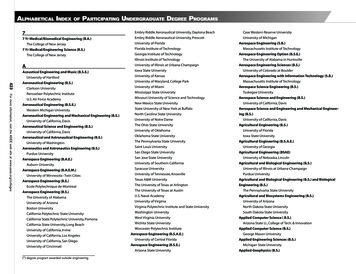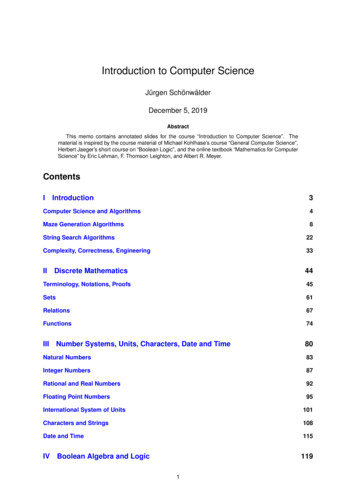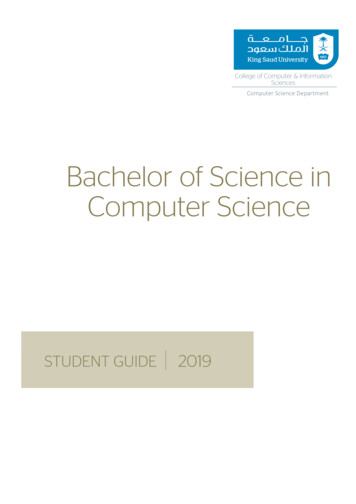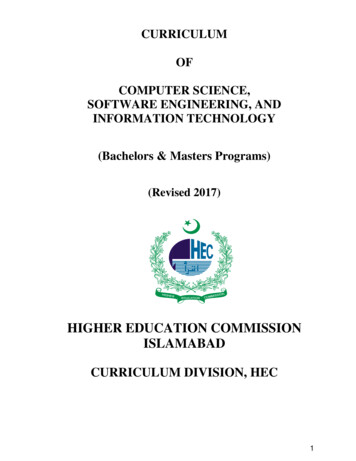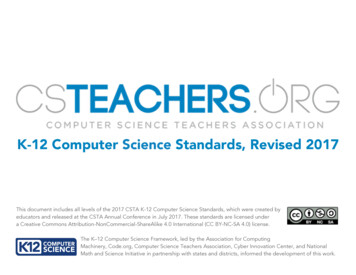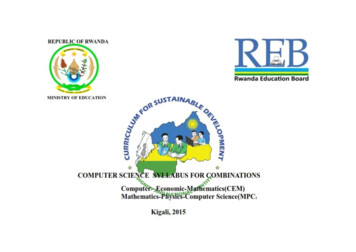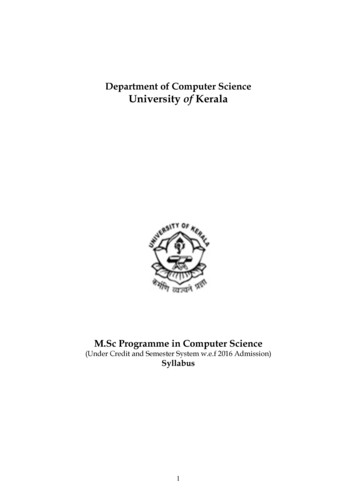
Transcription
Department of Computer ScienceUniversity of KeralaM.Sc Programme in Computer Science(Under Credit and Semester System w.e.f 2016 Admission)Syllabus1
AIMThis programme aims to strengthen the students' knowledge and deepen their understanding ofkey issues of specific application domains and areas in computer science and thereby enablethem to effectively and systematically strengthen and upgrade their technical capabilities inmeeting increasing demands in computer software systems and research & development.OBJECTIVES1. To allow graduates to increase their knowledge and understanding of computers and theirsystems, to prepare them for advanced positions in the workforce.2. To expose graduates to cutting edge developments in computing technology andcontemporary research.3. To encourage graduates to take up advanced innovative development work in the industry aswell as to pursue higher research degree qualifications.4. To make the graduates responsible, socially committed ,communicative citizens5. To provide graduates with great flexibility through extensive choices of electives to respondto rapidly changing industry needs as well as their interests6. To give graduates an introduction to industrial-style methods of analysis, design,implementation, testing and documentation in software development;7. To produce a new breed of computer science graduates that have a broad background ininformation technology along with project management and people skills8. To mould Graduates with strong technical expertise, and ability to work effectively ininterdisciplinary teams and be able to tackle problems that require both technical and nontechnical solutions.2
Structure of the ProgrammeSemester Course )Semester mester IVCOS-D-441Course TitleMathematical Foundations of Computer ScienceAdvanced Operating SystemsData Structure and Algorithms Using PythonComputer Networks and Information SecurityLab-ICase Study-ISystem Software and Compiler DesignMachine Learning TechniquesAdvanced Database Management SystemsObject Oriented Software EngineeringLab-IICase Study-IICredit333322333222Network Administration and Management Using LinuxDigital Image ProcessingDistributed Computing33Parallel ComputingPattern RecognitionData AnalyticsLab-IIICase Study-III33322Wireless Sensor NetworkCloud ComputingMedical Image Processing333Internet of Things3Social Network Analysis33Agent TechnologyFractals and Applications3Cyber Security and Cyber Law3Project & Viva-VoceList of External ElectivesCourse No SubjectCOS-X-421 Computational Social ScienceCOS-X-431 Introduction to Scientific Programming3316Credit22
SEMESTERCOUSE CODECOURSE TITLESCIENCECREDITS:I: COS-C-411: MATHEMATICAL FOUNDATIONS OF COMPUTER:3AIMTo familiarize the students with the foundations in discrete mathematics commonly requiredin many areas of Computer Science.OBJECTIVES To discuss the fundamental concepts and tools in discrete mathematics with emphasison their applications to Computer Science. To develop computational thinking and problem-solving skills of students. To understand the theoretical foundations of Mathematics those are used for problemsolving in Computer Science.COURSE les,types,randomexperiments,events,sample space,rules, CDF,PDF,PMF distributions, Bayes theorem,combinatorics, conditional probability Statistics: Introduction, parameters descriptive andgraphic statistics, parameter estimations, hypothesis testing and inferencesMODULE II: Review of Set theory , Relations:Definition,Properties of binary Relations,equivalence, transitive closure,compatibility and partial ordering relations. Functions: InverseFunction Compositions of functions, recursive ,hashing functions and mathematicalinductions.MODULE III: Linear algebra:Matrices,vectors,Determinants,linear systems,Matrix eigenvalue problems,vector differential calculas-gradient of a scalar field,divergence and curl of avector field, Vector integral calculas-Introduction to line integrals and double integrals,Green’s theorem in the plane, ,Divergence theorem of Gauss,Stoke’s thoremMODULE IV: Fourier Analysis: Fourier series,Even and odd functions,complex igonometricpolynomials,fourierintegrals,Fourier cosine and sine transforms,Discrete and fast fourier transformsMODULE V: Numeric Analysis: Introduction, solution of equations by iteration,interpolation, numeric integration and differentiation, numeric linear algebra-Linear Systems:Gauss Elimination, LU factorization, matrix inversion, III conditioning norms, Least squaresmethod.MODULE VI: Introduction to formal languages: Concepts of automata theory, Finiteautomata: Deterministic finite automata, Non- Deterministic finite automata, Conversion:Regular Expression to NFA and NFA to DFAREFERENCES4
Erwin Kreyszig, ”Advanced Engineering Mathematics” (9th Edition), 2006 John Wiley& Sons , ISBN-13: 978-0-471-72897-9 John.E.Hopcroft, Rajeev Motwani, Jeffrey D. Ullman, “Introduction to AutomataTheory, Languages, and Computation”(3rd Edition) ,2006 Prentice Hall, ISBN: 9780321455369 Lipschutz & Seymour, Schaum’s outlines “Discrete Mathematics”( revised 3rdEdition), 2017, Pu McGraw Hill Education, ISBN-13: 978-1259062537 Michael Baron ,”Probability and statistics For computer scientists” (2nd edition),Chapman and Hall/CRC, ISBN-13: 978-1439875902SEMESTERCOURSE CODECOURSE TITLECREDITS:I: COS-C-412: ADVANCED OPERATING SYSTEMS:3AIMThe purpose of this course is to impart knowledge on the advanced concepts in operatingsystems and to study about message passing, distributed shared memory, synchronizations, anddistributed file systems.OBJECTIVES To identify the significance of operating systems in the computing device. To provide the fundamentals of distributed operating systems. Recognize critical resources and explain the behaviour of semaphores.COURSE CONTENTMODULE I: Distributed Computing System – Distributed Computing System Models –Distributed Operating System – Issues in Designing a Distributed Operating System –Distributed Computing Environment (DCE).MODULE II: Message Passing: Desirable Features of a Good Message-Passing System –Issues in IPC by Message Passing – Synchronization – Buffering – Multidatagram Messages– Encoding and Decoding of Message Data – Process Addressing – Failure Handling – GroupCommunication.MODULE III: Distributed Objects and Remote Invocation -Introduction-Communicationbetween distributed objects-Remote procedure calls - Events and notifications. Introduction toName Services- Name services and DNS - Directory and directory services.MODULE IV: Distributed Shared Memory: General Architecture of DSM Systems – Designand Implementation Issues of DSM – Granularity – Structure of Shared Memory Space –Consistency Models – Replacement Strategy – Thrashing – Other Approaches to DSM –Heterogeneous DSM – Advantages of DSM.MODULE V: Synchronization: Clock Synchronization – Event Ordering - Mutual Exclusion– Deadlock – Election Algorithms.MODULE VI: Distributed File Systems: Desirable Features of a Good Distributed File System– File Models – File Accessing Models – File Sharing Semantics – File Caching Schemes –File Replication – Fault Tolerance – Atomic Transactions – Design Principles.REFERENCES5
Siberschartz A and Galvin P, Operating system Concepts, 8thEd AddisionWesley,2009. Pradeep K. Sinha, Distributed Operating Systems Concepts and Design, PHI Pvt.Ltd, 2008. Andrew S. Tanenbaum, Modern Operating Systems, PHI Pvt. Ltd., Third Edition, 2010 William Stallings, Operating Systems, 5ed, Pearson Education, 20076
SEMESTERCOURSE CODECOURSE TITLECREDITS:I: COS-C-413: Data Structure and Algorithms Using Python:3AIMThis course covers the advanced data structures and algorithms, concentrating on the designand implementation of efficient algorithms. The aim of the course is to append the knowledgeof advanced data structures and algorithms, hence provide a solid background in design ofalgorithms with the help of hands on experiments using Python.OBJECTIVES To introduce the concept of nonlinear data structures – tree and graphs. To explain the need for efficiency in data structures and algorithms. To apply methods to analyze running time and estimate the efficiency of the algorithms. To understand and apply the concept of various bio-inspired algorithms. To find appropriate data structures and design efficient algorithm for any kind ofproblems. To write programs using Python.COURSE CONTENTMODULE I: Nonlinear Data Structures-Concepts and terminologies of Trees, binary treeimplementation and traversals; AVL tree-importance, left and right rotations of tree;MODULE II: B trees and B trees; Red Black Tree; Graphs – representations and traversals,Spanning Tree, Minimum Spanning Tree;MODULE III: Analyzing Algorithms- Asymptotic notations, Recurrences; DynamicProgramming- Multistage Graphs, All Pairs Shortest Path;MODULE IV: Randomized Algorithms; String Matching algorithms, Branch and Bound –Travelling Salesman ProblemMODULE V: Network Flows-Max flow, min-cut theorem; Ford-Fulkerson, Edmonds-Karpalgorithm, Bipartite Matching. P and NP-class problemsMODULE VI: Bio inspired Algorithms-Concepts and Basics of - Genetic algorithms, Swarmintelligence, Particle swarm optimization, Ant colony optimization, Evolutionary algorithmREFERENCES7
Thomas H Cormen, Charles E Leiserson, Ronald L Rivest, Clifford Stein, IntroductionTo Algorithms, MIT Press, 2001, ISBN 9780262032933 Alfred V. Aho, Data Structures and Algorithms, Addison-Wesley, ISBN9780201000238 Stephan Olariu, Albert Y. Zomaya, Taylor & Francis, Handbook of BioinspiredAlgorithms and Applications, ISBN 9781584884750 Nancy Arana-Daniel, Carlos Lopez-Franco, Alma Y. Alanis, Butterworth-Heinemann,Bio-inspired Algorithms for Engineering, ISBN 9780128137895 Peter Brass, Advanced Data Structures, Cambridge University Press, ISBN9780511437533 Rance D. Necaise, Data Structures and Algorithms Using Python, Wiley, ISBN9780470618295 Michael T. Goodrich, Roberto Tamassia, Michael H. Goldwasser, Data Structures andAlgorithms in Python; John Wiley & Sons, Incorporated; ISBN 97811184767348
SEMESTERCOURSE CODECOURSE TITLECREDITS:I: COS-C-414: COMPUTER NETWORKS AND INFORMATON SECURITY:3AIMThe aim of the course is to impart knowledge on the functions and working of ComputerNetworks. The principles and algorithms used in data security will give an insight on thedevolvement of security systems.OBJECTIVES To get an overview of TCP/IP reference model. To study in detail about Internet Protocols- IPV4 and IPV6. To learn about Internet routing protocols. To know about wireless LANs and WiMAX. To understand about basic cryptographic concepts and various security measures.COURSE CONTENTMODULE I: TCP/IP Reference model- an overview, TCP: features, segment structure,connection management, IP: functions, IPV4 datagram format, Addresses, IPV6, NetworkProgramming – Sockets, TCP, UDP.MODULE II: Routing Algorithms: Optimality principle, Shortest path algorithm, Flooding,Distance vector routing, Link state routing, Hierarchical routing, Broadcast routing, AnycastRouting, multicast routing. Routing in the Internet- Interior gateway routing protocols: OSPF,RIP, Exterior gateway Routing Protocols: BGP.MODULE III: Error detection and correction: Error detection codes- Parity, Checksums,Cyclic Redundancy Checks (CRCs). Error correction codes- Hamming codes, Binaryconvolutional codes, Reed-Solomon codes, Low-Density Parity Check codes.MODULE IV: Wireless LAN(802.11)-Architecture, Frame structure, Services- WEP (WiredEquivalent Privacy),WPA2, Broadband Wireless- WiMAX(802.16), Architecture, Framestructure, Bluetooth – Architecture, Applications, Frame structure.MODULE V: Cryptography: Encryption, Symmetric and Asymmetric cryptography, DES,AES, RSA, Key Management-Diffie-Hellman Key Exchange.MODULE VI: Network Security Authentication Applications- Kerberos, X.509Authentication Service, Email Security, PGP, S/MIME, IP Security, Web Security, SSL andTSL Security, Firewall Design Principles.REFERENCES9
Andrew S. Tanenbaum; David J. Wetherall, Computer networks 5th ed., ISBN: 9780-13-212695-3 Kurose,James F, Ross,Keith W , Computer networking: a top-down approach 6th ed.,Addison-Wesley ISBN: 9780132856201 Behrouz A. Forouzan Data Communications & Networking (sie) 4th ed., Tata McGraw-Hill 2009, ISBN- 9780070634145 William Stallings, Cryptography and Network Security–7th ed., Principles & Practice.,Pearson Education ISBN: 9780134444284 Atul Kahate Cryptography and Network Security 3rd ed., Tata Mc Graw-Hill 2013,ISBN: 9781259029882 Prakash C. Gupta, Cryptography and Network Security, PHI Learning 2015, ISBN:9788120350458SEMESTERCOURSE CODECOURSE TITLECREDITS:I: COS-C-415: Lab-I:2AIMTo provide practical knowledge in implementing various algorithms using Python language.OBJECTIVES To understand programming concepts including object oriented features. To implement non-linear data structures like trees etc. To study working of different algorithms such as Multistage Graphs, All Pairs ShortestPath, Ford-Fulkerson, Edmonds-Karp algorithm using various algorithm designtechniques.COURSE CONTENTThe exercises related with the following are given for hands-on experiments Binary trees and its traversals AVL trees Minimum spanning trees B trees B trees Red black tree Multi stage graphs All Pairs shortest path problem Ford-Fulkerson Edmonds-Karp algorithm10
11
SEMESTERCOURSE CODECOURSE TITLECREDITS:I: COS-C-416: CASE STUDY-I:2AIMTo conduct a detailed investigation of any of the courses studied in the classroom through thepractical implementation of an existing work.OBJECTIVES Capture all of the details of the above subjects which are relevant to the purpose of thestudy, within a real life context. Learn the principles or the theory behind the concept through simulated problemsolving and decision-making. Learn actively (by doing) rather than passively (by simply listening to lecturers orreading), and reinforcing the applicability of theory to practical situationsCOURSE CONTENTA case study is a detailed investigation done by a single individual or group on a specific topicthat is covered in the first semester. Case studies can be qualitative or quantitative in nature,and often combine elements of both. Case studies allow students to fully understand how anintervention worked, or why an intervention had an effect in a particular case.12
SEMESTERCOURSE CODECOURSE TITLECREDITS: II: COS-C-421: SYSTEM SOFTWARE AND COMPILER DESIGN:3AIMThe aim of this course is to give an in-depth knowledge on system software especially on theworking of compilers.OBJECTIVES To study in detail about assemblers. To learn about loaders and linking. To introduce about grammars. To develop an understanding of various phases of compilers.COURSE CONTENTMODULE I: Introduction to System Software, Assemblers- Basic Assembler FunctionMachine dependent and independent features- Control sections and program linking,Assembler Design Options- One pass and Multi pass Assemblers.MODULE II: Loading-Basic Loader Functions, Simple Bootstrap Loader, MachineDependent Loader Features: Relocation, Linking, Linking Loader, Loader Design Option:Linkage editors, Dynamic Linking.MODULE III: Grammars -Types of grammars-type 0, type 1, type 2, type 3. The relationshipbetween types of grammars.MODULE IV: Compilers- Compiler structure, Phases of compiler, Lexical analysis:Specification and recognition of tokens, regular expressions and regular languages.MODULE V: Syntax Analysis:- Role of Parser and parse trees. Representation of parse(derivation) trees as rightmost and leftmost derivations. Top-down parsers-Recursive descentparser. Bottom up parsers-shift reduce parsing, operator precedence parsing.MODULE VI: Semantic Analysis:-Static and Dynamic Type checking, Syntax DirectedTranslation: Types Of Syntax Directed Definition. Intermediate Codes-Quadruples, triples.Intermediate code generation: Three Address Codes Generation, Code Optimization-PrincipalSources Of Optimization, Code generation- Concepts and definitions, Directed acyclic graphrepresentation.REFERENCES Beck, Leland L, System Software: An introduction to system programming, 3edADDISON WESLEY Publishing Company Incorporated, 1997, ISBN:978020142300613
Aho, Alfred V; Ullman, Jeffrey D.,Principles of compiler design.5 ed. - Narosa, 2002ISBN : 9788185015613 D.M.Dhamdhere,Systemed.,2011 ISBN: 9780071333115ProgrammingTataMcgrawHill,1st Anuradha A Puntambekar, Compiler Design, 1st ed., Technical Publications, 2011ISBN: 9789350380871 Alfred V. Aho, Compilers: principles, techniques, & tools, 2nd ed., Pearson/AddisonWesley, 2007 ISBN: 978-032148681314
SEMESTERCOURSE CODECOURSE TITLECREDITS: II: COS- C-422: MACHINE LEARNING TECHNIQUES:3AIMMachine learning is the science of getting the computer to act without being explicitlyprogrammed. This course covers the fundamental techniques of machine learning and theirapplication.OBJECTIVES To introduce the fundamental problems of machine learning.To provide understanding on the basic algorithms and techniques in machine learning.To learn and understand the limitations of various machine learning algorithms.To understand the fundamental theory of neural networks and its applications.COURSE CONTENTMODULE I: Introduction to Machine Learning- Components of learning, learning models,Types of Machine Learning, Introduction to Supervised Learning and Unsupervised LearningReinforcement learning.MODULE II: Supervised Learning- Regression - Classification, Classifiers: Support VectorMachines- K Nearest Neighbour, Kernel- Decision Trees.MODULE III: Unsupervised Learning - K Means algorithm- Dimensionality Reduction,Principal components analysis - Linear Discriminant Analysis.MODULE IV: Artificial Neural Networks – Introduction, Neuron model, Single layer, Multilayer feed forward network, Learning algorithm, Back propagation network.MODULE V: Fuzzy Logic - Fuzzy sets, Membership function, Fuzzification Defuzzification– Fuzzy Inference systems, Fuzzy Rule-Based System, Overview of fuzzyexpert system - fuzzy decision making.MODULE VI: Introduction to Neuro fuzzy systems - An adaptive neuro-fuzzy inferencesystem or adaptive network-based fuzzy inference system (ANFIS),REFERENCES N.P.Padhy,”Artificial Intelligence and Intelligent Systems” Oxford UniversityPress,2005 S. Rajsekaran & G.A. Vijayalakshmi Pai, “Neural Networks, Fuzzy Logic and Genetic Algorithm: Synthesis and Applications” Prentice Hall of India, 2003. Stephen Marslland Machine Learning”- An Algorithmic Approach”, CRC Press, 2009.15
Laurance Fausett, Englewood cliffs, N.J., ‘Fundamentals of Neural Networks’, PearsonEducation, 1992. Timothy J. Ross, ‘Fuzzy Logic with Engineering Applications’, Tata McGrawHill,1997. Stephen R. Schach, Introduction to Object Oriented Analysis and Design , Tata McGraw-Hill, 2003. S.N.Sivanandam and S.N.Deepa, Principles of Soft computing, Wiley India Edition,2nd Edition, 2013. Simon Haykin, ‘Neural Networks’, Pearson Education, 2003. M.Gen and R,Cheng, Genetic algorithms and Optimization, Wiley Series inEngineering Design and Automation, 2000.SEMESTERCOURSE CODECOURSE TITLECREDITS: II: COS-C-423: ADVANCED DATABASE MANAGEMENT SYSTEMS:3AIMTo make the students familiar on the principles of advanced DBMS such as OODBMS anddata warehousing.OBJECTIVES To know about basic database concepts. To identify the essentials of database transactions and concurrency control systems. To know and understand the basics of OODBMS and DDBMS. To understand the concepts of data mining and data warehousing.COURSE CONTENTMODULE I: Review of basic concepts, Transaction Processing Concepts, DesirableProperties of Transactions, Schedules and Recoverability, Characterizing Schedules Based onSerializability, Transaction Support in SQLMODULE II: Concurrency Control Techniques, Two-Phase Locking Techniques forConcurrency Control, Concurrency Control Based on Timestamp Ordering, MultiversionConcurrency Control Techniques, Validation (Optimistic) Concurrency Control Techniques.MODULE III: Object Oriented Database Management Systems: Concepts, Compositeobjects, Issues in OODBMSs, Advantages and Disadvantages of OODBMSs.MODULE IV: Distributed Databases-concepts, Advantages and Disadvantages of DDBMS,homogeneous and Heterogeneous DDBMS, Function of DDBMS.MODULE V: Introduction: Data mining- Functionalities, Technologies, Applications, Majorissues in Data Mining, Classification of DM systems.16
MODULE VI: Data Warehouse: Basic Concepts, Data Warehouse Architecture, Design andUsage, Data Warehouse Implementation, Data warehouse schemas – OLAP, OLAM.REFERENCES Connolly, Thomas M; Begg, Carolyn E, Database systems: a practical approach toDesign, Implementation, and Management.6th ed., Pearson Education, 2015ISBN: 978-0132943260. C.J. Date, Introduction to Database Systems, Pearson Education 8th ed., 2009 ISBN:9780321197849. M. Tamer Ozsu, Patrick Valduriez, Principles of Distributed Database Systems, 3rd ed,Springer, 2011 ISBN: 9781441988348. Jiawei Han, Micheline Kamber, Jian Pei, “Data Mining: Concepts and Techniques”,Morgan Kaufmann, 2nd Ed., 2005 MK Publishers ISBN: 9780123814791. Building the DataWarehouse- W. H. Inmon, 4th ed.,Wiley Dreamtech India Pvt. Ltd2009 ISBN: 9788126506453. Margaret H. Dunham, “Data Mining: Introductory and Advanced Topics”, PrenticeHall, 1st ed., 2006 ISBN: 9788177587852.SEMESTERCOURSE CODECOURSE TITLECREDITS: II: COS-C-424: OBJECT ORIENTED SOFTWARE ENGINEERING:2AIMObject oriented development is a way to develop software by building the self contained andreusable modules that can be easily modified and replaced. Object oriented analysis providesus with a world of cooperating and collaborating classes and objects. The aim is to familiarizethe students with the concepts of object oriented analysis, development and UML diagrams.OBJECTIVES To introduce the Object Oriented Concepts and the Unified Approach.To develop a foundation for Object Oriented Analysis and Object Oriented Design.To impart an idea about Object Oriented Methodologies.To introduce Agile Software development methodology.To discuss Agent Oriented Software Engineering (AOSE) concepts.COURSE CONTENT17
MODULE I: Introduction – Object Oriented Systems development life cycle. Object orientedMethodologies- Booch's Methodology - Rambaugh's Methodology , Jacobson's MethodologyPatterns and FrameworksMODULE II: Fundamentals of Object Oriented design using Unified Modeling Language,UML- Use case diagram- Class diagram- Sequence diagram- collaboration diagram-State chartdiagram- Activity diagram- Component diagram- deployment diagramMODULE III: Object oriented analysis: Use Case Model- Identifying use cases Identifyingactors- Documentation- Object analysis - Classification-different approaches- IdentifyingClasses- Identifying Object relationships – Attributes and Methods.MODULE IV: Object oriented design: Design process- Design axioms - Colloraries- DesignPatterns- Designing Classes - Designing Protocols and Class visibility - Defining AttributesDesigning Methods-Guidelines for identifying bad designMODULE V: Agile Software Development - Agile Practices & Principles- ExtremeProgramming- Practices- Planning- Initial Exploration- Release and Iteration PlanningDefining "Done"- Task Planning- Iterating - Tracking, Testing- Test-Driven DevelopmentAcceptance Tests, Serendipitous ArchitectureMODULE VI: Software Quality Assurance- Bugs and Debugging- Testing StrategiesDeveloping test cases- Developing test plans- Debugging Principles- Introduction to AgentOriented Software Engineering:REFERENCES Ali Bahrami, Object Oriented Systems Development, Tata McGraw-Hill, 1999 Martin Fowler, UML Distilled , Second Edition, PHI/Pearson Education, 2002. James Rumbaugh, Ivar Jacobson, Grady Booch The Unified Modeling Language Reference Manual , Addison Wesley, 1999. Roger Pressman. S., Software Engineering : A Practitioner s Approach, (4thEdition),McGraw Hill, 1997. Stephen R. Schach, Introduction to Object Oriented Analysis and Design , TataMcGraw-Hill, 2003. Hans-Erik Eriksson, Magnus Penker, Brain Lyons, David Fado, UML Toolkit , OMGPress Wiley Publishing Inc., 2004. A survey of Agent-Oriented Software Engineering. Amund Tveit. NorwegianUniversity of Science and Technology. May 8, 2001. Teach Yourself UML in 24 Hours, Joseph Schmuller, 3rd Edition, ISBN 81-297-06091, Pearson Education, 2004 Grady Booch, James Rumbaugh, Ivar Jacobson, “UML User Guide”, Addison Wesley,2002. Craig Larman (2005) Applying UML and Patterns. An Introduction to Object-OrientedAnalysis and Design and Iterative Development, Third Edition,18
Lethbridge and Laganiere, "Object-Oriented Software Engineering: Practical softwaredevelopment using UML and Java"SEMESTERCOURSE CODECOURSE TITLECREDITS: II: COS-C-425: Lab-II:2AIMTo provide practical knowledge in SQL and drawing UML diagrams.OBJECTIVES To understand basic SQL commands. To know how to draw various UML diagrams.COURSE CONTENTLab exercises related with the following should be implemented in this course.1. Familiarize basic SQL commands.2. Queries for joining multiple relations.3. Nested queries.4. Implementing UML diagramsa. Class diagramb. Use case diagramc. Activity diagramd. State chart diagrame. Sequence diagramf. Collaboration diagramSEMESTERCOURSE CODECOURSE TITLECREDITS: II: COS-C-426: CASE STUDY-II:2AIMTo understand the detailed investigation of any of theory courses studied in the second semesterthrough the practical implementation of an existing work.OBJECTIVES Capture all of the details of the above subjects which are relevant to the purpose of thestudy, within a real life context. Learn the principles or the theory behind the concept through simulated problemsolving and decision-making. Learn actively (by doing) rather than passively (by simply listening to lecturers orreading), and reinforcing the applicability of theory to practical situations.COURSE CONTENT19
A case study is a detailed investigation done by a single individual or group on a specific topicthat covers in the second semester. Case studies allow students to fully understand how anintervention worked, or why an intervention had an effect in a particular case.SEMESTERCOURSE CODECOURSE TITLECREDITS: II: COS-E-427(i): NETWORK ADMINISTRATION AND MANAGEMENT USING LINUX:3AIMTo familiarize the students in the tools and techniques used for network administration andmanagement.OBJECTIVES To identify the essentials of network administration, management and security To know about networking concepts. To understand more about Unix and Linux. To learn about routing mechanisms, firewall and gateway configuration.COURSE CONTENTMODULE I: Global Concepts for Administration and Management & Security andAdministration; Hardware, switches routers and gateways; Hardware interfaces: ethernet,ADSL and modems; Networking software - network configuration: TCP/IP, port mapping;Classfull and classless network addressing;MODULE II: System Backup, and Software Installation. system backup and utilities,compiling source code into programs and installing programs using Red Hat Package Manager.20
MODULE III: Introduction to Unix and Windows server; DHCP and Bootp servers; NetworkInformation Services - Configuring Network Services and Security. Discussed types ofnetwork services, configuring DNS, DHCP, Apache, Samba, NFS, FTP, NIS, and SSH.MODULE IV: Networked file systems: Linux File system Administration. the File systemHierarchy Standard, file and directory management commands, finding files, linking files, fileand directory permissions and ownership and special permissions, the /dev directory and devicefiles, file system types, mounting, working with floppy disks, working with CD-ROMS,working with hard disks, hard disk partitioning, monitoring disk usage, checking file systemsfor errors, and hard disk quotasMODULE V: Basic routing mechanisms, routing protocols and strategies; Domain NameServers; Network monitoring and traffic flows; Securing Your Server and Network.- restrictinguser access to the network, password properties, and intruder lockout. restricting administrativeaccess to the network, protecting servers and workstations from viruses, common internalsecurity problems, and firewall technologies.MODULE VI: Firewall and Gateway configuration - iptables, fwbuilder; Caching servers andproxy servers - squid. Network Performance- Queuing, Buffering, Error Rates,Retransmission. Fault Discovery, Fault Analysis, Fault Resolution, Backup/RecoveryREFERENCES Terry Dawson, Gregor Purdy, Tony Bautts, Linux Network Administrator's Guide,Infrastructure, Services, and Security 3rd ed., O'Reilly Media Publication ISBN:9780596005481 Kurose,James F ; Ross,Keith W , Computer networking: a top-down approach featuringthe internet. – Pearson Education Limited, 2017 ISBN: 978-0133594140. Murphy, IP version 6.0 network Administration, Shroff Publishers 1st ed., 2005 ISBN:9780596009342 Andrew S. Tanenbaum; David J. Wetherall, Computer networks 5th ed., ISBN:9780132126953SEMESTERCOURSE CODECOURSE TITLECREDITS: II: COS-E-427(ii): DIGITAL IMAGE PROCESSING:3AIMThis course covers the fundamental principles of Image Processing. The aim of this course isto expose the various applications of digital image processing.OBJECTIVES To learn digital image fundamentals. To study image enhancement and restoration techniques.21
To understand the segmentation techniques.COURSE CONTENTMODULE I: Digital Image Funda
William Stallings, Cryptography and Network Security-7th ed., Principles & Practice., Pearson Education ISBN: 9780134444284 Atul Kahate Cryptography and Network Security 3rd ed., Tata Mc Graw-Hill 2013, ISBN: 9781259029882 Prakash C. Gupta, Cryptography and Network Security, PHI Learning 2015, ISBN: 9788120350458 SEMESTER : I

